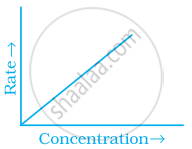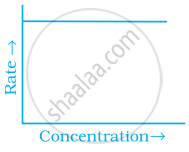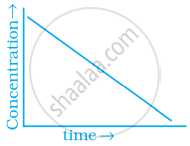Advertisements
Advertisements
Question
The value of rate constant of a pseudo first order reaction ______.
Options
depends on the concentration of reactants present in small amount.
depends on the concentration of reactants present in excess.
is independent of the concentration of reactants.
depends only on temperature.
Solution
The value of rate constant of a pseudo first order reaction depends on the concentration of reactants present in excess.
Explanation:
Let's start with what a pseudo-first-order response is.
Although the pseudo-first-order reaction looks to be an order, it belong to another order. it's a second-order reaction because it involves two reactants.
Let's have a look at a reaction.
\[\ce{CH3Br + OH -> CH3OH + Br}\]
So, the rate law for the reaction is
Rate = \[\ce{k[OH][CH3Br]}\]
Rate = \[\ce{k[OH][CH3Br] = k(constant) [CH3Br] = K' [CH3Br]}\]
Only the concentration of \[\ce{CH3Br}\] will change during the reaction and the rate will be determined by the reaction's modifications.
APPEARS IN
RELATED QUESTIONS
What is pseudo first order reaction? Give one· example of it.
For a reaction A + B ⟶ P, the rate is given by
Rate = k [A] [B]2
How is the rate of reaction affected if the concentration of B is doubled?
In any unimolecular reaction:
(i) only one reacting species is involved in the rate determining step.
(ii) the order and the molecularity of slowest step are equal to one.
(iii) the molecularity of the reaction is one and order is zero.
(iv) both molecularity and order of the reaction are one.
In a reaction if the concentration of reactant A is tripled, the rate of reaction becomes twenty seven times. What is the order of the reaction?
Match the graph given in Column I with the order of reaction given in Column II. More than one item in Column I may link to the same item of Column II.
| Column I | Column II | |
| (i) |  |
|
| (ii) |  |
(a) 1st order |
| (iii) |  |
(b) Zero-order |
| (iv) |  |
Assertion: Order of the reaction can be zero or fractional.
Reason: We cannot determine order from balanced chemical equation.
In the presence of a catalyst, the heat evolved or absorbed during the reaction.
For a reaction \[\ce{Cl2l(g) + 2No(g) -> 2NaCl(g)}\] the rate law is expressed as rate= K[Cl2] [No]2 what is the order of the reaction?
The rate constant for the reaction \[\ce{2H2O5 -> 4NO2 + O2}\] is 30 × 10–5 sec–1. if the rate is 204 × 10–5 mol L–1 S–1, then the concentration of N2O5 (in mol–1) is-
A reaction is second order with respect to a reactant. How is the rate of reaction affected if the concentration of the reactant is reduced to half?
